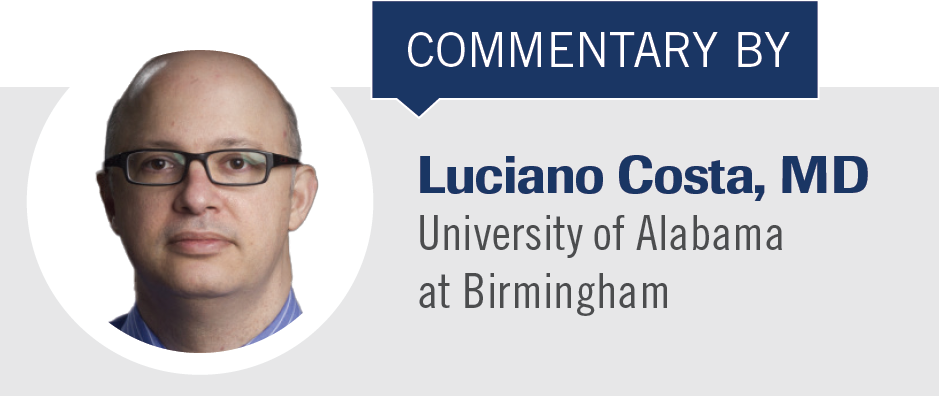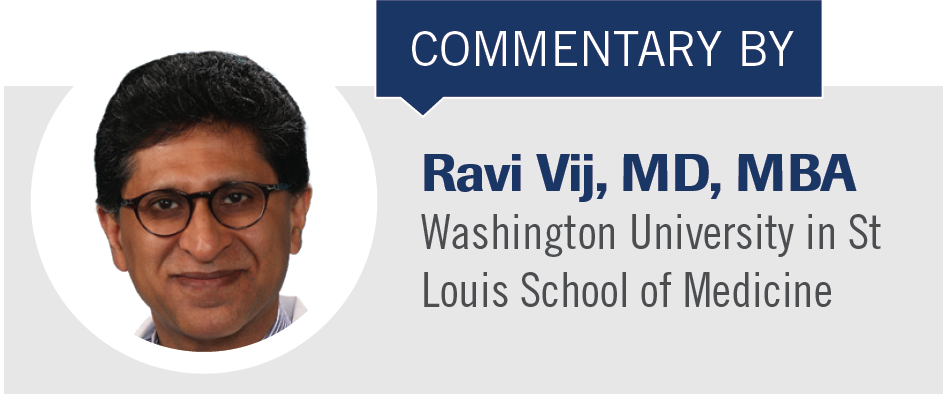Recap: Alabama and Washington Universities Face-Off on Multiple Myeloma at ASH
Ravi Vij, MD, MBA, and Luciano Costa, MD, face off over myeloma data from ASH 2022.
Design of the phase 3 MAIA trial (NCT02252172)
Evaluating daratumumab (Darzalex), lenalidomide (Revlimid), and dexamethasone (DRd) vs Rd in patients with previously untreated multiple myeloma who are eligible for high-dose therapy.
DRd arm:
• 25 mg of lenalidomide orally on days 1 to 21 for each 28-day cycle
• 40 mg of intravenous dexamethasone once a week
• Subcutaneous daratumumab at 1800 mg every 4 weeks
Rd arm:
• 25 mg of lenalidomide orally on days 1 to 21 of each 28-day cycle
• 40 mg of dexamethasone orally or intravenously
Primary end point:
• Progression-free survival (PFS)
Secondary end points:
• Complete response or better
• Very good partial response or better
• Minimal residual disease negativity
Luciano Costa, MD, Reviews Updated MAIA Data From ASH Meeting

CANCERNETWORK®: What were the main takeaways?
COSTA: The MAIA trial was a randomized phase 3 trial that took what was at a time considered the standard of care for patients with newly diagnosed multiple myeloma that are not eligible for transplant. This trial was mostly conducted in Europe in patients over the age of 70. When compared with the standard of care for those patients [treated with] Rd or DRd, all drugs were continued until progression, intolerance, or loss of follow-up. The study has been reported initially as showing an incredible benefit for the triple-combination arm in PFS and most recently has been updated to also show improvement in overall survival (OS), making the combination of DRd standard of care for patients with newly diagnosed myeloma who are not eligible for autologous transplant.
What was presented recently at the 2022 American Society of Hematology (ASH) Annual Meeting and Exposition was a follow-up life assessment showing that not only were there more frequent, deeper, and longer-lasting responses but also there was the expected improvement in quality of life associated with the use of the DRd. What is, to me, most impressive about the trial is [that] with a regimen that is used in patients who were for the most part in their 70s, the median PFS now exceeds 5 years, and [that at] a time not so long ago would [have been] considered outstanding…even for much younger patients treated with an autologous transplant.
CANCERNETWORK®: What are some unmet needs in the space that MAIA helped address?
COSTA: There are several unmet needs for patients with newly diagnosed multiple myeloma. One that is straightforward is to have a regimen that works for most people and maintains remission for a long period of time. There is also the issue of toxicity. Ideally, we want to have deeper responses that last long and on therapies that are well tolerated and improve quality of life. The regimen supported by MAIA meets several of those or addressed several of those unmet needs, in the sense that you have a regimen that gives a response in more than 90% of patients. Those responses are mostly durable, on a regimen that is well tolerated [and] has been shown to improve quality of life. It’s not perfect. Like with any myeloma therapy, the performance is not as great in patients with high-risk disease. Another caveat to that program is that the regimen was tested to continue until progression or intolerance. There is a real need to pursue more simplified and abbreviated and, if possible, limited-duration therapy. That’s something that has not yet been addressed in that particular population.
Design of the phase 3 SWOG S0777 trial (NCT00644228)
Examining the use of lenalidomide, bortezomib (Velcade), and dexamethasone (RVd) vs RD in patients with previously untreated multiple myeloma.
RVd arm:
• Oral dexamethasone on days 1, 2, 4, 5, 8, 9, 11, and 12
• Oral lenalidomide on days 1 to 14
• Intravenous bortezomib over 3 to 5 seconds on days 1, 4, 8, and 11
Rd arm:
• Oral dexamethasone on days 1, 8, 15, and 22
• Oral lenalidomide on days 1 to 21
Primary end point
• PFS
Secondary end points
• OS
• Response rates
Ravi Vij, MD, MBA, on the SWOG S0777 Trial

CANCERNETWORK®: What were the main takeaways?
VIJ: This was the long-term follow-up of the randomized phase 3 SWOG S0777 study that looked at RVd, comparing it with Rd, in patients with previously untreated myeloma who are not intended to go for stem cell transplant. The median PFS for patients who received RVd was 41 months, compared with 29 months for Rd. The median OS for the 3-drug regimen was not reached and was about 69 months for Rd. There were subset analyses that were performed in this presentation. It was clear that the improvement seen with the 3-drug regimen was maintained even when adjusting for age. This once again proves that RVd is and remains an appropriate standard of care for patients, irrespective of age.
The key takeaway from the SWOG [S0777] study was that even with a longer-term follow-up, the superiority of the 3-drug regimen of RVd is clear, compared with the 2-drug regimen of Rd. And this is irrespective of patient age that you see this benefit, that it remains a valid treatment option for patients irrespective of age.
CANCERNETWORK®: What treatments are needed in this space, and where is it headed?
VIJ: Currently there are several ongoing clinical trials, the results of which are eagerly awaited, that are looking at bringing 4-drug regimens even for patients not headed to stem cell transplantation. The 4-drug regimens have become a mainstay of treatment for transplant-eligible patients already. But for transplant-ineligible patients, we still tend to use the 3-drug regimens.
In the future, adding a CD38 antibody, be it daratumumab or isatuximab [Sarclisa], is expected to also become the standard of care once [data from] those trials looking at [2-, 3-, or 4-drug regimens] are presented at future meetings.
For patients with multiple myeloma, we are fortunate that we have made tremendous progress in the last 20 years, with the mainstay of therapy being proteasome inhibitors, immunomodulatory drugs, and CD38 antibodies. We’re entering a new era now with a whole new group of targets that have already shown their efficacy in later lines of therapy, including bispecifics; CAR [chimeric antigen receptor] T [cells] to BCMA [B-cell maturation antigen]; and other targets including GPRC5D and FCRF5.
We expect that with time, these will move into the paradigm of treatment earlier in the course [of disease] and will benefit even more patients with multiple myeloma.
Reference
- Facon T, Kumar SK, Weisel K, et al. Daratumumab plus lenalidomide and dexamethasone in patients with transplant-ineligible newly diagnosed multiple myeloma: Maia age subgroup analysis. Blood. 2022;140(suppl 1):10133-10136. doi:10.1182/ blood-2022-163555
EP: 1.SWOG S0777 Trial Proves VRd To Be Viable Option for Untreated Myeloma That Is Unintended for ASCT
EP: 2.Expert Offers Considerations For Frontline Combination Therapies in Multiple Myeloma
EP: 3.Ongoing Trials May Pave Way To Bring Later-Line Therapies Upfront in Newly Diagnosed Multiple Myeloma
EP: 4.MAIA trial Supports Use of D-Rd in Transplant-Ineligible Patients With Myeloma
EP: 5.GRIFFIN Trial Supports Use of Dara-VRd in Transplant-Eligble Patients With Myeloma
EP: 6.Ongoing Trials Aim to Determine Best Regimen for Transplant-Ineligible Patients With Myeloma
EP: 7.Future of Myeloma Treatment ‘Quite Exciting’ With New Immunotherapies
EP: 8.Recap: Alabama and Washington Universities Face-Off on Multiple Myeloma at ASH
